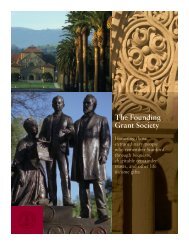Undergraduate Financial Aid: A Defining Commitment [PDF]
Undergraduate Financial Aid: A Defining Commitment [PDF]
Undergraduate Financial Aid: A Defining Commitment [PDF]
You also want an ePaper? Increase the reach of your titles
YUMPU automatically turns print PDFs into web optimized ePapers that Google loves.
2<br />
“…keeping open an avenue whereby<br />
the deserving and exceptional may rise<br />
through their own efforts.”<br />
Jane Stanford, Stanford University co-founder<br />
“We believe there is no better investment<br />
than to support the students who will<br />
become tomorrow’s leaders.”<br />
John hennessy, President and Bing Presidential Professor, Stanford University<br />
Striving to Stay Affordable StAnforD hAS long offereD A generouS finAnCiAl AiD progrAm. But in the pASt, mAny<br />
talented students were deterred by the “sticker price” and the complexity of the financial<br />
aid process. It became clear that it was time to reset the equation. From 2005 through<br />
2008, the university made substantial changes to its financial aid program, reinforcing our<br />
foundational pledge to the “deserving and exceptional” and simplifying the message that<br />
top-quality higher education is accessible to students from all backgrounds.<br />
DouG Plummer<br />
Cover photo: STeve GlADfelTer<br />
Today, parents of U.S. students with incomes under<br />
$100,000 a year and assets typical for their income<br />
level do not pay tuition. Parents earning less than<br />
$60,000 a year are not expected to pay tuition or<br />
contribute to the costs of room, board, and other<br />
educational expenses. Scholarships, along with state<br />
and federal grants when applicable, make up the<br />
difference. families with incomes at higher levels may<br />
also qualify for assistance, especially if more than<br />
one child is enrolled in college.<br />
All aid recipients are still expected to help finance<br />
their own education. In the past, the student contribution<br />
was based on the expectation that a student<br />
would also take out loans. The expected contribution is now low enough that most<br />
students are able to meet it with summer jobs, part-time campus work, savings, and/or<br />
outside scholarships. As a result, Stanford students today incur far less debt than<br />
the national average. of the students earning undergraduate degrees in 2011–12,<br />
75 percent graduated debt-free.<br />
These changes have sent a simple and strong message reaffirming Stanford’s commitment<br />
to access and affordability. All evidence shows that the message is being heard—<br />
loud and clear. Applications for admission have increased substantially, and the changes<br />
are reducing the financial pressure on our students and their families. Approximately<br />
30 percent of undergraduates benefit from the zero-tuition or zero-parent-contribution<br />
policies. As we seek to attract the best and brightest, the enhanced policies have<br />
allowed us to remain competitive with peer institutions that have also expanded<br />
their financial aid offerings in recent years.


![Undergraduate Financial Aid: A Defining Commitment [PDF]](https://img.yumpu.com/19129351/2/500x640/undergraduate-financial-aid-a-defining-commitment-pdf.jpg)



![Leadership Giving: Stanford Reunion Campaigns 2013 [PDF]](https://img.yumpu.com/19129379/1/190x245/leadership-giving-stanford-reunion-campaigns-2013-pdf.jpg?quality=85)
![Creating a Charitable Lead Annuity Trust [PDF] - Giving to Stanford](https://img.yumpu.com/19129374/1/190x245/creating-a-charitable-lead-annuity-trust-pdf-giving-to-stanford.jpg?quality=85)
![Leadership Giving to The Stanford Fund [PDF] - Giving to Stanford ...](https://img.yumpu.com/19129353/1/190x245/leadership-giving-to-the-stanford-fund-pdf-giving-to-stanford-.jpg?quality=85)

![The Stanford Fund for Undergraduate Education [PDF] - Giving to ...](https://img.yumpu.com/19129349/1/190x245/the-stanford-fund-for-undergraduate-education-pdf-giving-to-.jpg?quality=85)
![Stanford Interdisciplinary Graduate Fellowships [PDF] - Giving to ...](https://img.yumpu.com/19129346/1/190x245/stanford-interdisciplinary-graduate-fellowships-pdf-giving-to-.jpg?quality=85)
![Donor Advised Funds [PDF] - Giving to Stanford - Stanford University](https://img.yumpu.com/19129344/1/190x245/donor-advised-funds-pdf-giving-to-stanford-stanford-university.jpg?quality=85)

